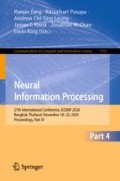Abstract
Alzheimer’s disease (AD) is the most common form of neurodegenerating disorder accounting for 60–80% of all dementia cases. The lack of effective clinical treatment options to completely cure or even slow the progression of disease makes it even more serious. Treatment options are available to treat the milder stage of the disease to provide symptomatic short-term relief and improve quality of life. Early diagnosis is key in the treatment and management of AD as advanced stages of disease cause severe cognitive decline and permanent brain damage. This has prompted researchers to explore innovative ways to detect AD early on. Changes in speech are one of the main signs of AD patients. As the brain deteriorates the language processing ability of the patients deteriorates too. Previous research has been done in the English language using Natural Language Processing (NLP) techniques for early detection of AD. However, research using local languages and low resourced language like Nepali still lag behind. NLP is an important tool in Artificial Intelligence to decipher the human language and perform various tasks. In this paper, various classifiers have been discussed for the early detection of Alzheimer’s in the Nepali language. The proposed study makes a convincing conclusion that the difficulty in processing information in AD patients reflects in their speech while describing a picture. The study incorporates the speech decline of AD patients to classify them as control subjects or AD patients using various classifiers and NLP techniques. Furthermore, in this experiment a new dataset consisting of transcripts of AD patients and Control normal (CN) subjects in the Nepali language. In addition, this paper sets a baseline for the early detection of AD using NLP in the Nepali language.
Access this chapter
Tax calculation will be finalised at checkout
Purchases are for personal use only
References
Zhou, X., Ashford, J.W.: Advances in screening instruments for Alzheimer’s disease. Aging Med. 2, 88–93 (2019)
Bakkour, A., Morris, J.C., Wolk, D.A., Dickerson, B.C.: The effects of aging and Alzheimer’s disease on cerebral cortical anatomy: specificity and differential relationships with cognition. Neuroimage 76, 332–344 (2013)
Domoto-Reilly, K., Sapolsky, D., Brickhouse, M., Dickerson, B.C., Initiative, Alzheimer’s Disease Neuroimaging.: Naming impairment in Alzheimer’s disease is associated with left anterior temporal lobe atrophy. Neuroimage 63, 348–355 (2012)
Thapa, S., Singh, S., Jain, D.K., Bharill, N., Gupta, A., Prasad, M.: Data-driven approach based on feature selection technique for early diagnosis of Alzheimer’s disease. In: 2020 International Joint Conference on Neural Networks (IJCNN). IEEE (2020)
Faber-Langendoen, K., Morris, J.C., Knesevich, J.W., LaBarge, E., Miller, J.P., Berg, L.: Aphasia in senile dementia of the Alzheimer type. Ann. Neurol. 23, 365–370 (1988)
Orimaye, S.O., Wong, J.S., Golden, K.J., Wong, C.P., Soyiri, I.N.: Predicting probable Alzheimer’s disease using linguistic deficits and biomarkers. BMC Bioinform. 18, 34 (2017)
Fritsch, J., Wankerl, S., Nöth, E.: Automatic diagnosis of Alzheimer’s disease using neural network language models. In: 2019 IEEE International Conference on Acoustics, Speech and Signal Processing (ICASSP), pp. 5841–5845. IEEE (2019)
Chen, J., Zhu, J., Ye, J.: An attention-based hybrid network for automatic detection of Alzheimer’s disease from narrative speech. In: Proceedings of Interspeech, pp. 4085–4089 (2019)
Becker, J.T., Boiler, F., Lopez, O.L., Saxton, J., McGonigle, K.L.: The natural history of Alzheimer’s disease: description of study cohort and accuracy of diagnosis. Arch. Neurol. 51, 585–594 (1994)
Naseem, U., Musial, K.: DICE: deep intelligent contextual embedding for Twitter sentiment analysis. In: 15th International Conference on Data Analysis and Recognition (ICDAR 2019), pp. 953–958. IEEE (2019)
Singh, P.: Natural language processing. Machine Learning with PySpark, pp. 191–218. Springer, Heidelberg (2019). https://doi.org/10.1007/978-1-4842-4131-8
Naseem, U., Khan, S.K., Razzak, I., Hameed, I.A.: Hybrid words representation for airlines sentiment analysis. In: Liu, J., Bailey, J. (eds.) AI 2019. LNCS (LNAI), vol. 11919, pp. 381–392. Springer, Cham (2019). https://doi.org/10.1007/978-3-030-35288-2_31
Mikolov, T., Sutskever, I., Chen, K., Corrado, G.S., Dean, J.: Distributed representations of words and phrases and their compositionality. In: Advances in Neural Information Processing Systems, pp. 3111–3119 (2013)
Grave, E., Bojanowski, P., Gupta, P., Joulin, A., Mikolov, T.: Learning word vectors for 157 languages. arXiv preprint arXiv:1802.06893 (2018)
Lamsal, R.: 300-Dimensional Word Embeddings for Nepali Language. IEEE Dataport (2019)
Kim, Y.: Convolutional neural networks for sentence classification. arXiv preprint arXiv:1408.5882 (2014)
Author information
Authors and Affiliations
Corresponding author
Editor information
Editors and Affiliations
Rights and permissions
Copyright information
© 2020 Springer Nature Switzerland AG
About this paper
Cite this paper
Thapa, S., Adhikari, S., Naseem, U., Singh, P., Bharathy, G., Prasad, M. (2020). Detecting Alzheimer’s Disease by Exploiting Linguistic Information from Nepali Transcript. In: Yang, H., Pasupa, K., Leung, A.CS., Kwok, J.T., Chan, J.H., King, I. (eds) Neural Information Processing. ICONIP 2020. Communications in Computer and Information Science, vol 1332. Springer, Cham. https://doi.org/10.1007/978-3-030-63820-7_20
Download citation
DOI: https://doi.org/10.1007/978-3-030-63820-7_20
Published:
Publisher Name: Springer, Cham
Print ISBN: 978-3-030-63819-1
Online ISBN: 978-3-030-63820-7
eBook Packages: Computer ScienceComputer Science (R0)

